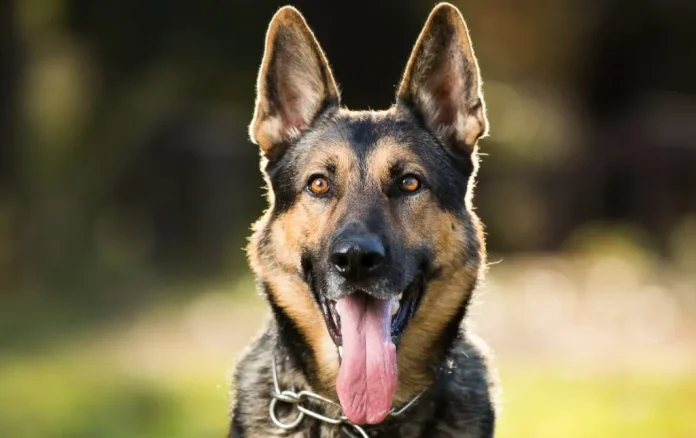The German Shepherd, also known as the Alsatian if you’re living in the United Kingdom, is a large dog breed prized for their incredible intelligence and unwavering loyalty. One the smartest breeds, ranked just behind the Border Collie, the GSD is highly trainable. Perhaps one of the most well known breeds, this remarkable dog’s unique abilities are often put to work. Because of their inherent desire to work, German Shepherds often find roles as in law enforcement, including bomb detection and forensics. Additionally, they often work in search and rescue, therapy, and as service dogs. While we tend to think of German Shepherds serving as these modern-day roles, their name indicates they were first used for herding.
Known for their protective instincts, affectionate nature, and boundless energy, the German Shepherd dog makes a loyal and loving companion. They thrive when paired with active individuals or families, including those with children. However, these wonderful dogs truly excel when their remarkable blend of intelligence and devotion is appreciated. Keeping your German Shepherd mentally and physically stimulated is key to their happiness. Don’t let their high intelligence go to waste! Keep them engaged by teaching tricks, going on outings, or even trying to teach them to “speak” using recordable dog buttons.
When considering a German Shepherd dog, it’s advisable to prioritize adopting from rescue organizations or shelters. However, if you’re on the search for German Shepherd puppies and decide to purchase, it’s crucial to choose a reputable breeder. Conduct thorough research to ensure that the breeder follows ethical practices and prioritizes the well-being of their dogs. Reputable breeders prioritize the health and temperament of their dogs. They also conduct necessary health screenings, and provide a nurturing environment for their German Shepherd puppies.
Is the German Shepherd a good family dog?
Renowned for their affectionate nature, obedience, and protective instincts, German Shepherds are often lauded as excellent family companions. However, these noble canines thrive on constant mental stimulation and an active lifestyle, which may pose challenges for novice owners. If you and your household can provide ample opportunities for physical exercise and mentally engaging activities, a German Shepherd could be an ideal addition to your family. As always, begin socialization early, particularly if you have children in the family. Also make sure your children know how to safely and respectfully interact with dogs to build an early positive relationship with your pup.
Quick Facts
- Origin: Germany
- Size: Adult males typically stand around 24 to 26 inches (60 to 65 cm) at the shoulder, while females range from 22 to 24 inches (55 to 60 cm). Their weight can range from 50 to 90 pounds (23 to 41 kg).
- Breed Group: Herding Group
- Lifespan: 9 to 13 years
- Coat: GSDS has a double coat that consists of a dense, straight, or slightly wavy outer coat and a soft undercoat. Colors include black and tan, sable (a mix of black and tan with a pattern of dark-tipped hairs), and solid black.
- Temperament: The German Shepherd’s temperament is characterized by loyalty, determination, and intelligence.
- Exercise Needs: High.
- Training: German Shepherds are among the most intelligent dog breeds and are highly trainable.
- Grooming: Regular grooming is important. Their double coat sheds year-round and more heavily during shedding seasons. Brushing a few times a week helps manage shedding and keeps their coat healthy.
- Health: Common concerns include hip and elbow dysplasia, conditions affecting the ears (such as ear infections) and eyes (such as cataracts), as well as degenerative myelopathy.
- The most famous GSD is probably Strongheart, who starred in over 20 silent films in the early 1920s.
- If you’ve ever wondered, “How fast can a German Shepherd run?”, prepare to be amazed. These athletic dogs are capable of incredible sprinting speeds, reaching up to an astonishing 30 miles per hour.
- The Black German Shepherd’s coat color comes from a recessive gene. Along with the White German Shepherd and the Isabella Blue German Shepherd, a liver-sable colored GSD, the Black German Shepherd is considered rare.
German Shepherd Pictures
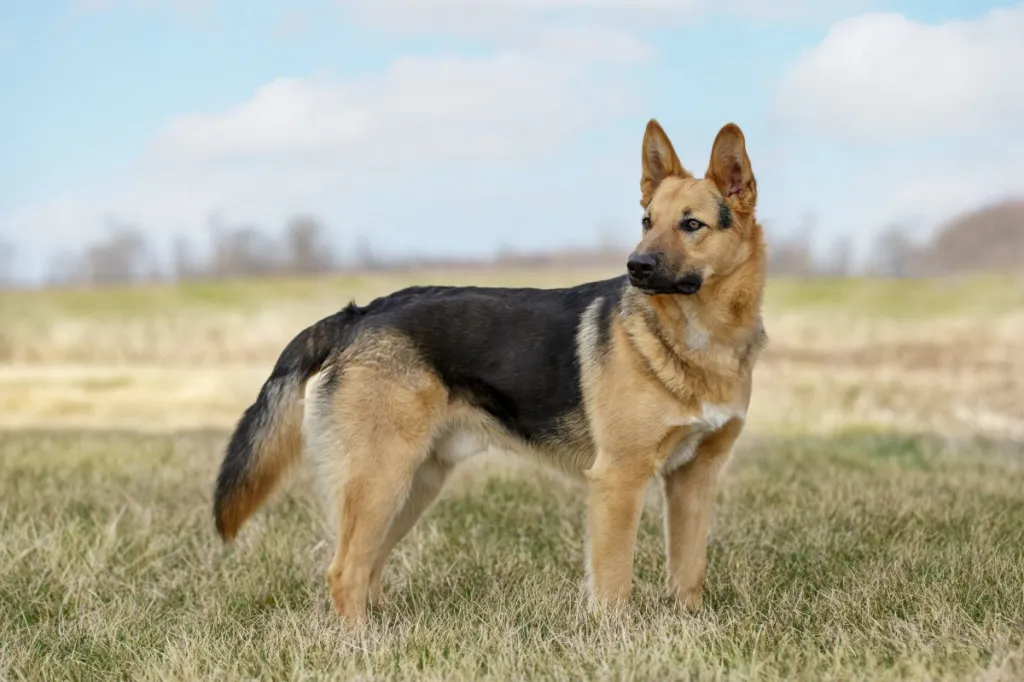
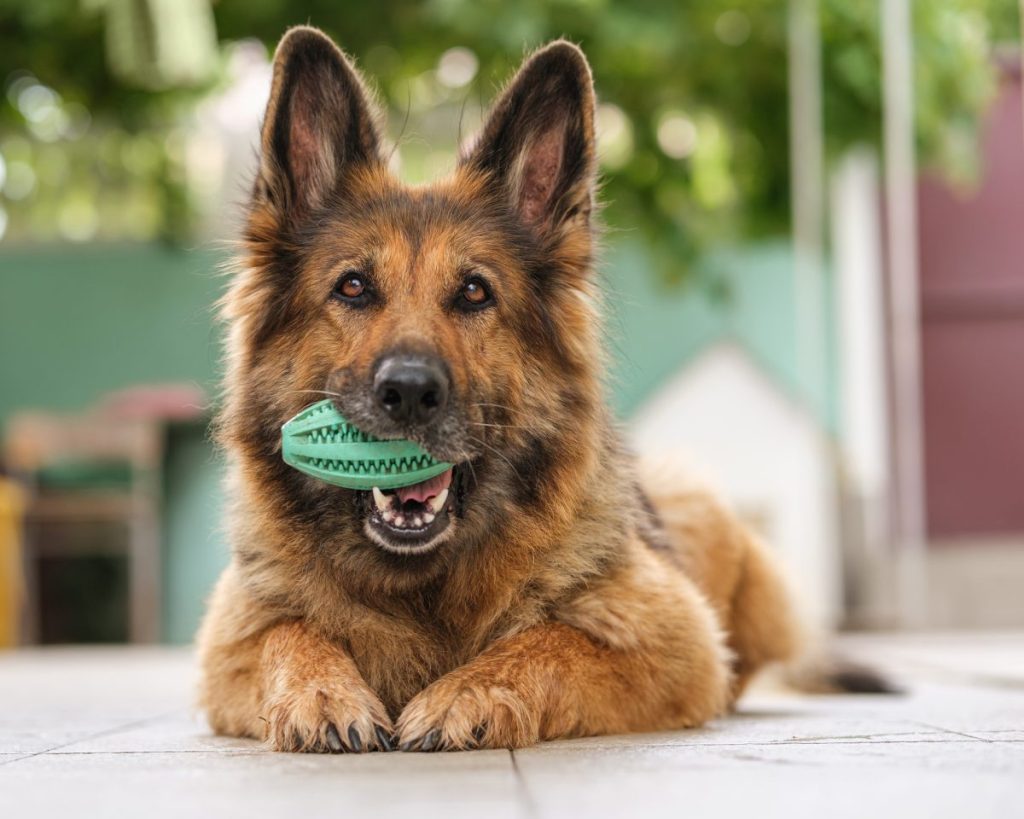
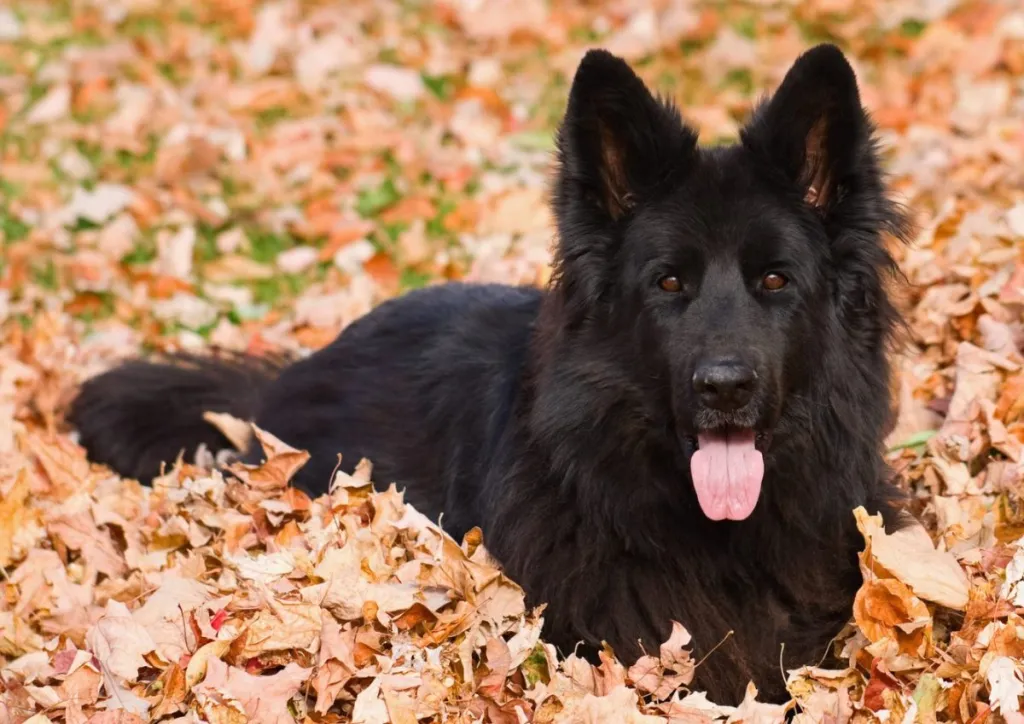
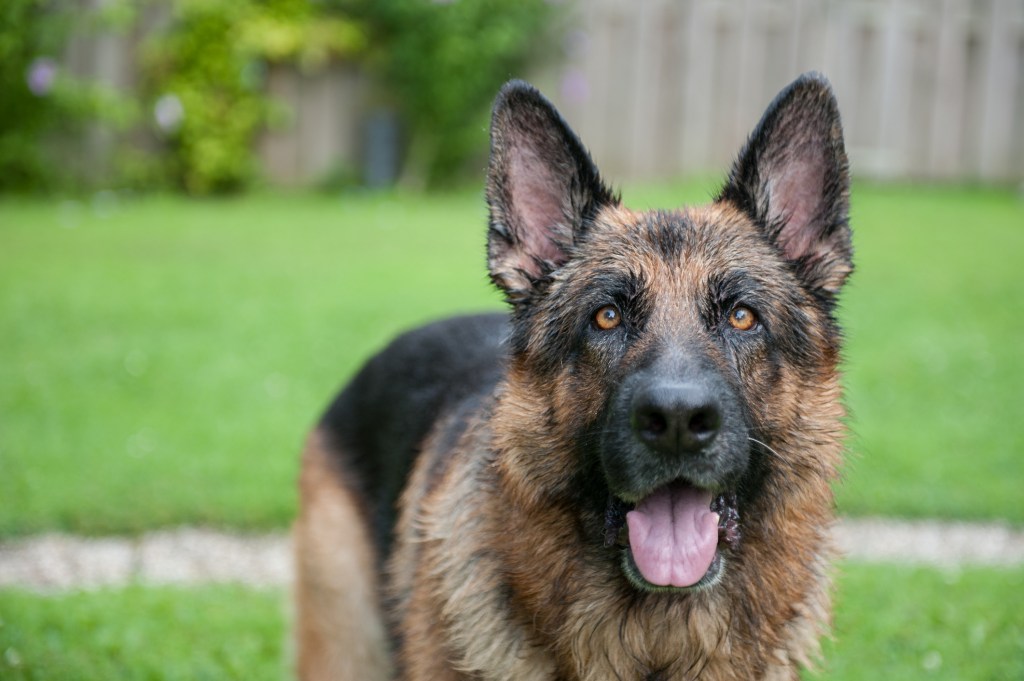

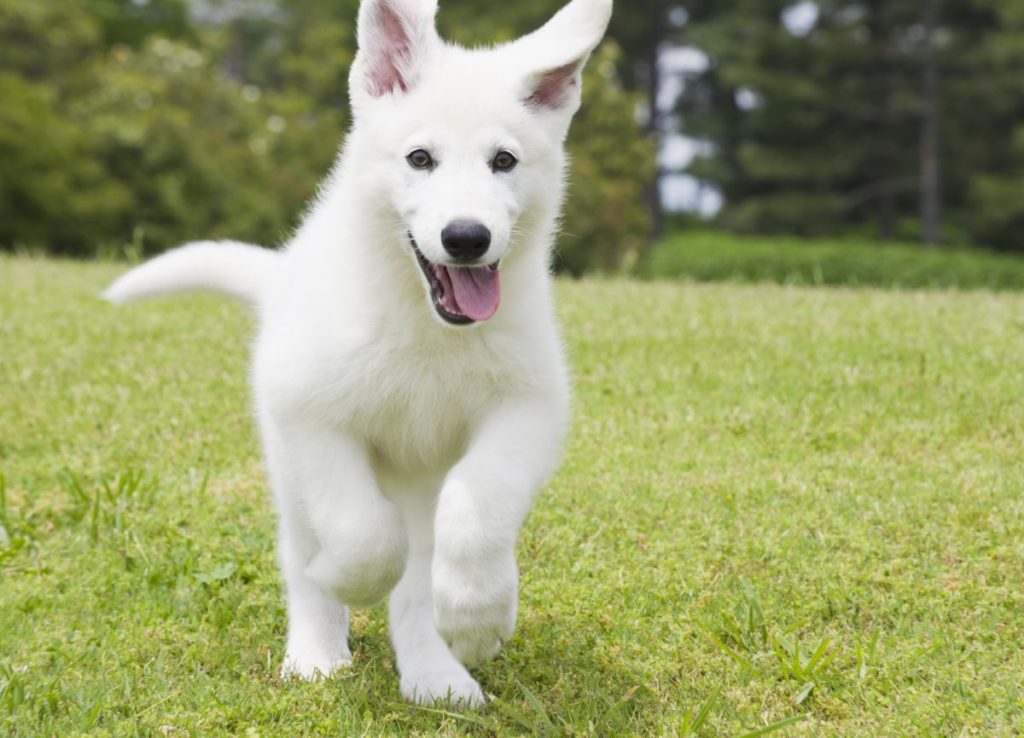
German Shepherd Dog Overview
The German Shepherd Dog, recognized as the Alsatian in Great Britain and various parts of Europe, stands as one of the foremost canine breeds globally, often finding its place in the top 10 most favored breeds in the United States. Its distinction and fame can be attributed, in part, to a poignant tale from World War I. Amidst the turmoil of war, Corporal Lee Duncan rescued a young puppy from a war-torn breeding kennel in France. This pup, later named Rin Tin Tin, would become a legendary figure in the entertainment industry, starring in numerous films and amassing an astonishing 10,000 fan letters weekly during the pinnacle of its stardom.
Beyond the silver screen, the German Shepherd has embraced a multitude of roles. From aiding the visually impaired and apprehending criminals to detecting illicit substances and serving in the military, this versatile breed has exhibited its prowess. It has also demonstrated its compassion by visiting the sick and exhibiting its herding instincts with livestock. Notably, German Shepherds played a heroic role as search and rescue dogs amidst the wreckage of the World Trade Center after the 9/11 attacks, offering solace to both rescue workers and grieving families.
However, the German Shepherd’s suitability must be carefully considered, as it may not align with every household. Originating as herding dogs tasked with day-long duties, they possess substantial energy levels, necessitating ample physical activity and mental stimulation. A lack thereof can lead to undesirable behaviors like excessive barking and destructive chewing. Characterized by an aloof and occasionally wary disposition, they excel as vigilant watchdogs but may not exude the warm welcome typical of a family pet. Nevertheless, early exposure to diverse situations and individuals during puppyhood can cultivate adaptability.
When adopting a German Shepherd, the lineage’s origin can influence the dog’s traits. Descendants from American breeders often prioritize the pursuit of dog show accolades and distinctive aesthetics, sometimes at the expense of traditional working abilities. Conversely, German-bred dogs focus on both appearance and functional capabilities, undergoing rigorous tests to uphold the breed’s renowned physical and mental standards. These dogs tend to exhibit heightened energy and determination. However, the only true method to ascertain a dog’s nature is through direct interaction. Thus, a visit to a shelter provides an invaluable opportunity to connect with your potential lifelong companion before making a commitment.
German Shepherd Dog Highlights
Versatile Working Dogs: German Shepherds are renowned for their versatility and intelligence, making them one of the most widely used working dog breeds. They excel in various roles, including police work, search and rescue, detection, and as service dogs. Their keen sense of smell, strength, and trainability contribute to their success in these demanding tasks.</p>
Loyal Companions: German Shepherds are known for their unwavering loyalty and devotion to their families. They form strong bonds with their owners and are often protective, making them excellent watchdogs. Despite their imposing appearance, well-socialized German Shepherds are typically approachable and gentle with children, making them a popular choice for families.
Intelligent and Trainable:</strong> Renowned for their intelligence, GSDs are quick learners and highly trainable. They thrive on mental stimulation and require regular training sessions to keep their minds engaged. This intelligence, combined with their work ethic, makes them adept at learning various commands and tasks, contributing to their success in obedience competitions and working roles.
Distinctive Appearance: German Shepherds have a distinctive appearance with a strong, well-muscled body and a noble head. They typically have a double coat that can be short or long, and their coloration often includes a black saddle with tan or red markings. Their erect ears and alert expression add to their regal and commanding presence.
Energetic and Active: German Shepherds are high-energy dogs that require regular exercise to maintain their physical and mental well-being. They enjoy activities such as running, playing fetch, and engaging in interactive games. Regular exercise helps prevent boredom and contributes to a happy, well-balanced German Shepherd.
Potential Health Considerations: While generally healthy, German Shepherds can be prone to certain health issues, including hip dysplasia and elbow dysplasia. Responsible breeding practices and regular veterinary check-ups can help mitigate these concerns and ensure the overall health of the breed.
German Shepherd Dog History
The German Shepherd breed’s origins trace back to the late 19th century, particularly to the visionary efforts of Captain Max von Stephanitz. An officer in the German cavalry, Captain von Stephanitz harbored a distinct ambition: to cultivate an unparalleled German herding dog. In preceding centuries, German farmers and their European counterparts relied on dogs to manage and safeguard their livestock. Certain canines gained legendary status for their herding prowess, prompting shepherds to traverse great distances to mate their female dogs with distinguished sires. However, as von Stephanitz astutely observed, the local herding dogs had yet to evolve into a distinct and unified breed.
In 1898, upon retiring from his military career, von Stephanitz embarked on a new chapter dedicated to his passion: experimenting with dog breeding to fashion an exceptional German herding dog. Drawing inspiration from the British, renowned for their exceptional herding dogs, von Stephanitz studied various breeding techniques. He traversed Germany, attending dog shows and closely observing German-style herding dogs. Amidst the fine examples he encountered—athletic, intelligent, and capable—he found a crucial element lacking: a single dog that encapsulated all these traits.
In 1899, von Stephanitz’s journey brought him to a dog show, where he was captivated by a wolf-like canine named Hektor Linksrhein. Swiftly acquiring the dog and renaming him Horand v Grafeth, von Stephanitz was profoundly impressed by Horand’s robust physique and sharp intellect. This encounter motivated him to establish the Verein für deutsche Schäferhunde (Society for the German Shepherd Dog) and lay the foundation for the breed using Horand’s descendants.
While von Stephanitz initially intended the breed to excel in herding, the industrialization of Germany led him to envision a different path. Recognizing the diminishing need for herding dogs, he pivoted toward emphasizing the breed’s suitability for police and military work. Leveraging his military connections, von Stephanitz secured the German government’s endorsement of the breed’s capabilities. During World War I, German Shepherds proved their mettle as Red Cross dogs, messengers, rescuers, guards, and sentinels.</p>
<p>The breed gained traction in the United States during and after the war, as Allied servicemen admired the dogs’ courage and intelligence. Among them was an American corporal from Los Angeles, who rescued a newborn puppy from a war-ravaged kennel in France. This puppy, named Rin Tin Tin, became a cinematic sensation, starring in numerous films and propelling the breed’s popularity in America.
However, the aftermath of the war introduced challenges. The breed’s German roots became stigmatized, prompting changes in nomenclature. The American Kennel Club (AKC) renamed the breed to “Shepherd Dog” in 1917, while in England, it became the “Alsatian Wolf Dog.” It wasn’t until later that the original name, German Shepherd Dog, was reinstated.
Von Stephanitz remained a steadfast advocate for the breed’s integrity and quality. By 1922, he recognized certain unfavorable traits emerging in German Shepherds, such as poor temperament and dental issues. He instituted a rigorous quality control system, requiring dogs to pass rigorous tests before breeding, assessing intelligence, temperament, athleticism, and overall health.
Divergence between American- and German-bred German Shepherds escalated after World War II. American breeding prioritized appearances and show wins, while German Shepherds from Germany remained steadfast in their working abilities. In the face of performance challenges and genetic health concerns among American-bred dogs, a shift began, with some U.S. breeders reintroducing working dogs from Germany to restore the breed’s functional attributes.
German Shepherd Dog Size
The German Shepherd Dog is renowned for its striking appearance and impressive size. This breed falls squarely within the medium to large dog category, characterized by a strong and robust build that exudes both elegance and power. Adult German Shepherds typically possess a height range of 22 to 26 inches (56 to 66 cm) at the shoulders, with males often standing slightly taller than females. However, these measurements may vary based on factors such as genetics, lineage, and geographical regions of breeding.
The breed’s weight is equally notable, with adult German Shepherds usually weighing between 50 to 90 pounds (23 to 41 kg), again with males tending to be heavier than females. This weight range contributes to their substantial and muscular appearance, reflecting their historical role as herding and working dogs. Their well-proportioned body structure, characterized by a level back, strong hindquarters, and deep chest, further emphasizes their agility and strength.
German Shepherds’ size serves as a reflection of their multifaceted nature. While their imposing stature contributes to their role as capable guardians and protectors, it is important to note that their size is coupled with intelligence and an eager-to-please temperament. This blend of physical prowess and mental acuity positions them as versatile companions, excelling in various roles such as search and rescue, police work, service, and family pets.
Maintaining an ideal weight and overall health is crucial for the well-being of German Shepherds. Regular exercise, a balanced diet, and routine veterinary care contribute to their longevity and vitality. Additionally, responsible breeding practices play a significant role in upholding the breed’s size standards and preventing health issues associated with excessive or inadequate size.
German Shepherd Dog Personality
The German Shepherd’s personality is characterized by a subtle aloofness rather than overt aggression. These dogs are inclined toward reserve, forming connections not instantly but deeply, and once those bonds are forged, their loyalty knows no bounds. Within their family circle, they exhibit an affable and approachable demeanor, yet when faced with threats, they can transform into stalwart protectors, showcasing their exceptional watchdog abilities. Endowed with remarkable intelligence and trainable instincts, this breed thrives when given a purposeful task—no challenge is too great. From alerting a hearing-impaired individual to a doorbell’s chime to locating a victim buried under an avalanche, the German Shepherd’s capabilities seem boundless.
However, one aspect that requires careful consideration is their need for companionship and engagement. Prolonged periods of solitude do not align well with their nature. Without the necessary interaction, exercise, and opportunities to engage their sharp minds, they can experience boredom and restlessness. A German Shepherd left under-stimulated and isolated from family activities may resort to undesirable behaviors, such as excessive barking and destructive chewing.
In line with all canines, early socialization of your German Shepherd puppy proves pivotal for a well-rounded development. The German Shepherd should be exposed to diverse people, environments, sounds, and encounters during their formative stages. Such s=”yoast-text-mark”>href=”/socialization.html”>socialization lays the foundation for an adaptable and balanced adult dog, equipped to handle a variety of situations with confidence and ease. By embracing these qualities and providing suitable outlets for their energy and intellect, the German Shepherd can evolve into an outstanding companion and guardian, embodying the best of their remarkable personality traits.
German Shepherd Dog Health
German Shepherds typically enjoy good health, yet, akin to all breeds, they have susceptibility to specific health conditions. While not every German Shepherd will experience these ailments, it’s vital to familiarize yourself with potential issues if you’re contemplating adopting this breed.
-
Hip Dysplasia: This hereditary concern entails the improper fitting of the femur into the hip joint’s pelvic socket. Hip dysplasia can manifest with or without apparent symptoms. Some dogs may display lameness and discomfort in one or both hind legs, with arthritis potentially developing as they age. Screening for hip dysplasia through X-ray assessments is conducted by organizations like the Orthopedic Foundation for Animals or the University of Pennsylvania Hip Improvement Program. Dogs with hip dysplasia should not be used for breeding.
-
Elbow Dysplasia:</a> Primarily found in large breeds, this heritable condition results from differential growth rates among the elbow’s three constituent bones, causing joint instability. The consequence is painful lameness. Veterinary recommendations could encompass surgical intervention or pain management medications.
-
<strong>class=”</yoastmark”>”yoast-text-mark”>f=”https://dogtime.com/dog-health/100888-gastric-dilatation-volvulus-gdv-dogs-symptoms-causes-treatments”>Gastric Dilatation-Volvulus (Bloat): A life-threatening situation predominantly affecting deep-chested large dogs, bloat occurs when the stomach distends due to gas or air and subsequently twists. Immediate medical attention is crucial to prevent shock and possible fatality. Suspect bloat if your dog exhibits abdominal distension, excessive salivation, retching without vomiting, restlessness, lethargy, and rapid heart rate.
-
Degenerative Myelopathy: A progressive spinal cord ailment particularly targeting the hind legs’ communication with the brain. Dogs with DM struggle to coordinate hind leg movements, often progressing to an inability to walk. Treatment options are limited, although rare instances might involve vitamin deficiencies, necessitating vitamin supplementation.
-
Exocrine Pancreatic Insufficiency (EPI)</a>: This genetic pancreatic disorder diminishes digestive enzyme production, leading to impaired food digestion and absorption. Symptoms include gas, appetite loss, weight reduction, altered stools, and increased hunger. Diagnosis is straightforward through a blood test, with treatment involving the addition of pancreatic enzymes to the dog’s diet.
</li>
-
<s
- trong>=”yoast-text-mark” href=”/allergies-dog.html”>>Allergies: German Shepherds are susceptible to various allergies encompassing contact and food sensitivities. Indicators may involve persistent scratching, paw licking, and facial rubbing. Consult your vet if such symptoms emerge.
German Shepherd Dog Care
Bred originally for full-day herding duties, German Shepherds are engineered for activity. This translates to a surplus of energy that necessitates daily exercise for release. Extended periods of solitude without physical exertion can result in issues. Boredom and inactivity pave the way for undesirable behaviors, such as , digging, and . To satiate their energetic demands, German Shepherds require both physical engagement (jogging, playful sessions at a dog park) and mental stimulation (participation in agility<a class=”yoast-text-mark” href=””chewing</a”> or obedience competitions).
Similar to many herding breeds, German Shepherds have a penchant for vocalization. While barking isn’t inherently problematic, it may become so when stemming from boredom. Therefore, it’s advisable to include teaching the “Quiet” command as an integral part of their obedience training regimen. Furthermore, these dogs have an inclination for chewing, and their formidable jaw strength can swiftly demolish various materials. To prevent potential dental issues, ingestion of harmful substances, or choking hazards, it’s prudent to furnish them with safe chew toys and bones, ensuring they have engaging alternatives when playtime isn’t in session.
German Shepherd Dog Feeding
Tailoring a diet for a German Shepherd Dog requires consideration of their large size and elevated energy demands. Seeking guidance from your veterinarian or a certified nutritionist is prudent to determine the appropriate nourishment and portion sizes for your German Shepherd. As they progress through puppyhood, adulthood, and senior stages, their dietary requisites will evolve. Remaining attentive to these nutritional shifts is crucial.
For German Shepherd puppies, particular attention is necessary when it comes to feeding and physical activity. Their rapid growth between four and seven months leaves them susceptible to bone-related issues. To mitigate such concerns, a high-quality, low-calorie diet is advisable to regulate their growth rate. Until they reach around two years of age and their joints are fully developed, it’s recommended to avoid vigorous activities like running, jumping, or playing on hard surfaces such as pavement. Grass surfaces are more suitable, and puppy agility with minor jumps is permissible.
<p>Cautious portion control is essential to prevent excessive weight gain and potential joint complications. Striking a balance with treats, promoting regular exercise, and adhering to scheduled mealtimes, as opposed to constant access to food, safeguards against overfeeding. By being attentive to their dietary needs and mindful of their activity levels, you can contribute to the well-being and overall health of your German Shepherd.
German Shepherd Dog Coat Color And Grooming
Originally bred to manage flocks in challenging climates, the German Shepherd boasts a medium-length double coat that suits this task impeccably. This coat serves as a natural shield against rain, snow, and prevents the accumulation of burrs and dirt. The German Shepherd exhibits a diverse range of coat types and colors. While some may have long hair, the “optimal” German Shepherd displays a medium-length double coat. The outer layer features dense, straight hair that lies close to the body, occasionally presenting a wavy or wiry texture. The coat’s hues encompass a spectrum including black, black and cream, black and red, black and silver, black and tan, blue, gray, liver, sable, and white. Notably, the American Kennel Club does not endorse white as an accepted color for conformation shows, though they remain eligible for other competitions.
Famously known as “German shedders,” this breed experiences consistent shedding throughout the year, with distinct shedding episodes—akin to snowstorms—occurring twice annually. Prospective German Shepherd owners must brace for hair on various surfaces, from clothing to furniture. While no foolproof remedy exists for shedding, regular brushing, ideally two to three times a week, can help manage the hair situation by capturing more in the brush than on furnishings. A reliable vacuum cleaner also proves advantageous. ass=”yoast-text-mark”>ass=”yoast-text-mark”>ef=”/bathing.html”>Bathing</a> should be administered judiciously to avoid stripping the coat’s essential oils, which sustain its health. Despite their shedding reputation, German Shepherds tend to maintain a fairly clean and odor-free disposition.</p>
Maintaining the breed’s hygiene involves monthly href=”/nails.html”>nail trims and weekly ear checks, wiping out the ears with a damp cotton ball infused with gentle, pH-balanced ear cleaner to thwart potential infections. The German Shepherd’s penchant for chewing not only serves as an enjoyable habit but also contributes to dental cleanliness. Supplying durable and secure dental chew toys or bones can combat tartar buildup, especially on the back molars. Supplementing this with periodic brushing</a> using a soft toothbrush and dog-specific toothpaste enhances gum and teeth well-being.</p>
German Shepherd Dog Children And Other Pets
A well-trained German Shepherd that has been exposed to children, especially during their puppyhood, can make an excellent companion for kids. Some liken them to a blend of a caretaker and a guardian, as they exhibit gentleness and protective instincts towards the youngsters within their family. However, given their size, there is a potential for accidental bumps with toddlers or small children. Their reserved demeanor translates into a cautious approach with unfamiliar kids, yet their reliability generally prevails.
While not overtly exuberant, German Shepherds can harmoniously coexist with other dogs and pets, provided they receive proper guidance from their early days. Introducing an adult German Shepherd into a household with existing pets might pose challenges if the dog isn’t accustomed to socializing with other dogs or cats. In such cases, enlisting the aid of a professional trainer or seeking guidance from the rescue organization, if you obtained the adult German Shepherd from there, can prove beneficial.
German Shepherd Dog Rescue Groups
Many individuals acquire German Shepherds without a comprehensive grasp of the responsibilities associated with their ownership. A multitude of German Shepherds are seeking adoption or foster care, and numerous breed-specific rescue organizations are spread throughout the nation. Below are a few links to a few of these German Shepherd rescue groups.
- <a href=”https://www.coastalk9gsr.org/?gclid=Cj0KCQjwz8emBhDrARIsANNJjS4Y8ezSVDpWJeKYrBxLCRRqIqXfScmVn1ngwSVuGyJPMhOUWf-UBGYaAnNDEALw_wcB”>Coastal K9 German Shepherd Rescue
- Sedona Shepherd Sanctuary
- German Shepherd Dog Rescue of Georgia
- Mid Atlantic German Shepherd Rescue
German Shepherd Dog Breed Organizations
Finding a reputable dog breeder is one of the most important decisions you will make when bringing a new dog into your life. Reputable breeders are committed to breeding healthy, well-socialized puppies that will make great companions. They will screen their breeding stock for health problems, socialize their puppies from a young age, and provide you with lifetime support.
On the other hand, backyard breeders are more interested in making a profit than in producing healthy, well-adjusted dogs. They may not screen their breeding stock for health problems, and they may not socialize their puppies properly. As a result, puppies from backyard breeders are more likely to have both health and behavioral issues.
These clubs serve as a hub for enthusiasts, breeders, and owners, fostering a sense of camaraderie and a platform for sharing knowledge. From showcasing the breed’s excellence in conformation shows to promoting responsible ownership through training and education, these clubs play an integral role in preserving the breed’s integrity and advocating for its well-being.
- German Shepherd Dog Club of America
- World Union of German Shepherd Associations
More Info For You
- <ul>
- Adoption
- German Shepherd Dog Names
- Bringing Home Your Dog
- <li>
- e=”list-style-type: none;”>
- Feeding A Puppy
- Indoor Activities For Dogs</a>
- ref=”http://dogtime.com/dog-training-tricks-dunbar.html” target=”_blank” rel=”noopener”>Teaching Your Dog Tricks
- <li>
How To Take Pictures Of Your Dog


